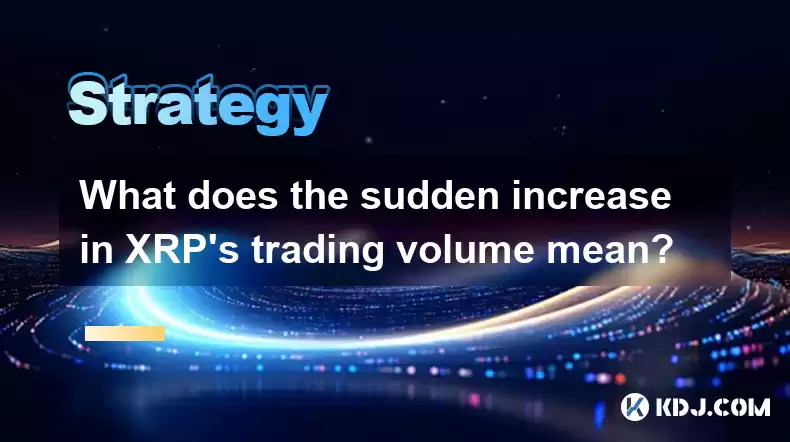-
 Bitcoin
Bitcoin $115100
1.27% -
 Ethereum
Ethereum $3675
2.71% -
 XRP
XRP $2.995
1.45% -
 Tether USDt
Tether USDt $1.000
0.02% -
 BNB
BNB $769.8
2.64% -
 Solana
Solana $168.0
3.25% -
 USDC
USDC $0.9999
-0.01% -
 TRON
TRON $0.3371
1.48% -
 Dogecoin
Dogecoin $0.2051
3.36% -
 Cardano
Cardano $0.7394
2.30% -
 Hyperliquid
Hyperliquid $38.15
0.42% -
 Stellar
Stellar $0.3966
-0.36% -
 Sui
Sui $3.486
2.93% -
 Chainlink
Chainlink $16.72
2.52% -
 Bitcoin Cash
Bitcoin Cash $568.0
4.36% -
 Hedera
Hedera $0.2440
2.59% -
 Ethena USDe
Ethena USDe $1.001
0.04% -
 Avalanche
Avalanche $22.16
2.06% -
 Litecoin
Litecoin $119.1
-0.73% -
 UNUS SED LEO
UNUS SED LEO $8.991
0.04% -
 Toncoin
Toncoin $3.232
-0.39% -
 Shiba Inu
Shiba Inu $0.00001233
2.82% -
 Uniswap
Uniswap $9.717
2.53% -
 Polkadot
Polkadot $3.664
1.85% -
 Dai
Dai $1.000
0.01% -
 Monero
Monero $281.2
-3.89% -
 Bitget Token
Bitget Token $4.350
1.55% -
 Cronos
Cronos $0.1428
5.07% -
 Pepe
Pepe $0.00001050
3.68% -
 Aave
Aave $262.3
3.54%
What does the sudden increase in XRP's trading volume mean?
A sudden spike in XRP's trading volume can signal increased liquidity and price volatility, prompting investors to adjust strategies based on market sentiment and technical indicators.
Apr 21, 2025 at 05:56 am

The sudden increase in XRP's trading volume can be an intriguing phenomenon for both seasoned and novice traders within the cryptocurrency market. Understanding the implications of such a surge is crucial for making informed decisions about buying, selling, or holding XRP. This article delves into the various factors that might contribute to a sudden increase in XRP's trading volume, what it might mean for the market, and how investors should respond.
Factors Contributing to Increased Trading Volume
Several elements can lead to a sudden spike in XRP's trading volume. Market sentiment and news are often primary drivers. For instance, if there are significant updates or announcements from Ripple Labs, the company behind XRP, traders might react by buying or selling the cryptocurrency, thus increasing the volume. Regulatory news can also have a profound impact; any news related to the SEC's stance on XRP or other regulatory bodies can cause fluctuations in trading activity.
Technical analysis indicators might also play a role. If XRP's price breaks through key resistance or support levels, it can trigger a wave of trading as investors adjust their positions based on these technical signals. Whale activity, or the actions of large holders of XRP, can also lead to increased volume. When whales buy or sell large amounts of XRP, it can cause significant shifts in the market.
Implications for Market Dynamics
A sudden increase in XRP's trading volume can signal several things about the market dynamics. Increased liquidity is one immediate effect; higher trading volumes mean that it's easier to buy and sell XRP without significantly impacting the price. This can be attractive to traders who value the ability to enter and exit positions quickly.
Price volatility often accompanies increased trading volume. When more traders are active, the price of XRP can experience sharper fluctuations. This can be both an opportunity and a risk: traders might capitalize on these movements for short-term gains, but they also face the risk of significant losses if the market moves against them.
Market sentiment can also be inferred from trading volume. A sudden spike might indicate growing interest or confidence in XRP, especially if it's accompanied by a rising price. Conversely, if the volume increase is coupled with a falling price, it might signal a bearish outlook among traders.
How Investors Should Respond
When faced with a sudden increase in XRP's trading volume, investors need to consider their strategy carefully. For long-term holders, such a surge might not necessitate immediate action. However, it's wise to monitor the situation closely and stay informed about any developments that might have triggered the volume increase.
Short-term traders might see this as an opportunity to capitalize on price movements. If the volume increase is driven by positive news or bullish technical indicators, traders might consider entering long positions. Conversely, if the surge seems driven by negative news or bearish signals, short positions might be more appropriate.
Risk management is crucial in such scenarios. Regardless of the strategy, investors should set stop-loss orders to protect against unexpected market moves. Additionally, diversifying across different cryptocurrencies can help mitigate the risk associated with any single asset, including XRP.
Analyzing the Data: Tools and Techniques
To make sense of a sudden increase in XRP's trading volume, investors can use various tools and techniques. Trading platforms like Binance, Coinbase, and Kraken provide real-time data on volume and price movements. Investors can use these platforms to monitor XRP's volume and correlate it with price changes.
Technical analysis software such as TradingView or MetaTrader can help investors identify patterns and trends in XRP's trading volume. These tools often include indicators like the Volume Weighted Average Price (VWAP) or the On-Balance Volume (OBV), which can provide deeper insights into the relationship between volume and price.
News aggregators and social media platforms are also valuable resources. Websites like CoinDesk or CryptoSlate can provide timely news that might explain sudden volume spikes. Monitoring discussions on platforms like Twitter or Reddit can also offer insights into market sentiment and potential triggers for increased trading activity.
Case Studies: Historical Examples of Volume Spikes
Looking at historical examples can provide valuable lessons about the implications of sudden volume increases in XRP. In early 2021, XRP experienced a significant volume spike following a favorable court ruling in its ongoing legal battle with the SEC. This surge in volume was accompanied by a sharp rise in price, reflecting bullish sentiment among traders.
Another notable instance occurred in late 2020, when news of Ripple's potential IPO caused a flurry of trading activity. The volume increase was driven by speculation about the potential impact of the IPO on XRP's value, demonstrating how market rumors and expectations can influence trading behavior.
In contrast, a sudden volume spike in mid-2018 was driven by negative news about regulatory scrutiny from the SEC. This time, the increased volume was accompanied by a falling price, reflecting bearish sentiment and a rush to sell among traders.
Frequently Asked Questions
Q: Can a sudden increase in XRP's trading volume be manipulated by market actors?
A: Yes, market manipulation is a possibility. Large traders or "whales" might engage in practices like "pump and dump" schemes, where they artificially inflate the volume and price of XRP before selling off their holdings at a profit. Investors should be cautious and look for other confirming indicators before making trading decisions based solely on volume spikes.
Q: How does XRP's trading volume compare to other cryptocurrencies like Bitcoin and Ethereum?
A: XRP's trading volume can be significantly influenced by its specific market dynamics and news related to Ripple Labs. While Bitcoin and Ethereum often have higher overall trading volumes due to their larger market caps and broader adoption, XRP can experience sudden spikes that rival those of the top cryptocurrencies when driven by specific catalysts.
Q: Are there any specific indicators investors should watch alongside trading volume to make better-informed decisions?
A: Yes, several indicators can be useful. The Relative Strength Index (RSI) can help identify overbought or oversold conditions, while the Moving Average Convergence Divergence (MACD) can signal potential trend changes. Additionally, monitoring the order book on trading platforms can provide insights into the immediate supply and demand dynamics for XRP.
Q: How can investors use volume analysis to predict future price movements of XRP?
A: Volume analysis can be a useful tool for predicting price movements, but it should be used in conjunction with other indicators. A sudden increase in volume accompanied by a price rise might suggest continued upward momentum, while a volume spike with a falling price could indicate potential downward pressure. However, volume alone is not a definitive predictor, and investors should consider broader market trends and news as well.
Disclaimer:info@kdj.com
The information provided is not trading advice. kdj.com does not assume any responsibility for any investments made based on the information provided in this article. Cryptocurrencies are highly volatile and it is highly recommended that you invest with caution after thorough research!
If you believe that the content used on this website infringes your copyright, please contact us immediately (info@kdj.com) and we will delete it promptly.
- Avalanche vs. Ruvi AI: Daily Sales Tell a Story of Crypto Disruption
- 2025-08-07 06:29:35
- DeSoc: The Crypto to Buy Now for a Decentralized Future (and Maybe 43x Gains!)
- 2025-08-07 06:50:16
- Meme Coins in August 2025: Riding the Rally Wave
- 2025-08-07 06:56:08
- Big Whales, Altcoins, and Heavy Transactions: What's Moving the Crypto Market?
- 2025-08-07 06:29:35
- TRX, RUVI, and CoinMarketCap: What's Buzzing in the Crypto Sphere?
- 2025-08-07 05:31:17
- Cryptos Primed for 5x Gains? Ozak AI Spotlights Hot Projects
- 2025-08-07 05:41:42
Related knowledge

How to avoid common crypto investment mistakes?
Jul 13,2025 at 01:35am
Understanding the Risks of Crypto InvestmentInvesting in cryptocurrency can be highly rewarding, but it also comes with significant risks. One of the ...

What is a long-short crypto strategy?
Jul 15,2025 at 10:56am
Understanding the Basics of a Long-Short Crypto StrategyA long-short crypto strategy is an investment approach where traders simultaneously take long ...

What is a long-short crypto strategy?
Jul 11,2025 at 01:28pm
Understanding the Basics of Long-Short Crypto StrategyA long-short crypto strategy is an investment approach where traders take both long and short po...

How to use the RSI indicator for crypto?
Jul 12,2025 at 03:56pm
Understanding the RSI Indicator in Cryptocurrency TradingThe Relative Strength Index (RSI) is a momentum oscillator used to measure the speed and chan...

Is copy trading a good strategy for crypto beginners?
Jul 12,2025 at 08:28am
Understanding Copy Trading in the Cryptocurrency MarketCopy trading is a strategy where novice traders replicate the trades of experienced investors a...

How to build a crypto portfolio with $1000?
Jul 13,2025 at 08:14pm
Understanding the Basics of Cryptocurrency InvestmentBuilding a crypto portfolio with $1000 starts with understanding the fundamentals of cryptocurren...

How to avoid common crypto investment mistakes?
Jul 13,2025 at 01:35am
Understanding the Risks of Crypto InvestmentInvesting in cryptocurrency can be highly rewarding, but it also comes with significant risks. One of the ...

What is a long-short crypto strategy?
Jul 15,2025 at 10:56am
Understanding the Basics of a Long-Short Crypto StrategyA long-short crypto strategy is an investment approach where traders simultaneously take long ...

What is a long-short crypto strategy?
Jul 11,2025 at 01:28pm
Understanding the Basics of Long-Short Crypto StrategyA long-short crypto strategy is an investment approach where traders take both long and short po...

How to use the RSI indicator for crypto?
Jul 12,2025 at 03:56pm
Understanding the RSI Indicator in Cryptocurrency TradingThe Relative Strength Index (RSI) is a momentum oscillator used to measure the speed and chan...

Is copy trading a good strategy for crypto beginners?
Jul 12,2025 at 08:28am
Understanding Copy Trading in the Cryptocurrency MarketCopy trading is a strategy where novice traders replicate the trades of experienced investors a...

How to build a crypto portfolio with $1000?
Jul 13,2025 at 08:14pm
Understanding the Basics of Cryptocurrency InvestmentBuilding a crypto portfolio with $1000 starts with understanding the fundamentals of cryptocurren...
See all articles

























































































